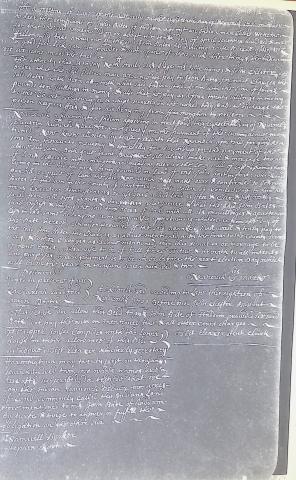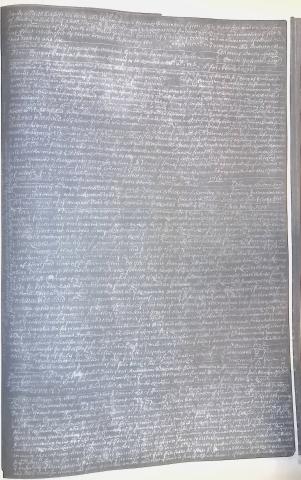Common Unities: Possession, Dispossession, & Community in Tunxis Land Records, 1640-1841

Common Unities: Possession, Dispossession, & Community in Tunxis Land Records, 1640-1841
The Tunxis, or the People Living at the Bend of the River, were the Indigenous inhabitants, from time out of mind, of Tunxis Sepos, what is now Farmington, Connecticut. While their land base in the early 17th Century extended throughout central Connecticut, overlapping with related Native communities along the lower Connecticut River watershed, the advent of European settlement at Sukiaug (Hartford) soon changed the contours of the Tunxis landscape and its community.
A land treaty in 1640 laid the ground for relations with English colonists and established one of the earliest Indian reservations in America at Tunxis Sepos. Over time, three separate reservation common land areas developed with additional parcels privately owned by Tunxis individuals appearing nearby.
From then to the late 1700s, as colonial settlement encroached upon Connecticut Native space, the Tunxis actively assimilated displaced Indian neighbors in an e pluribus unum (out of many, one) strategy that expanded their numbers, strengthened their political influence in Central Connecticut Indian Country, and most likely, insured, at least temporarily, their continued presence on the land.
Living among English neighbors burdened the Tunxis with continuous anxiety over land loss and violence. Mobility of Tunxis individuals back and forth to neighboring Native communities either because of work, social, or religious opportunities or traditional customs certainly occurred. Some Tunxis could be found at Stockbridge, Massachusetts, for example, as early as 1748. By 1774, however, the tribal land base at Farmington became unsustainable when many of the Tunxis began to sell their property to remove with other New England Indian communities to a place called Eeyamquittoowauconnuck or Brothertown in Oneida Country, New York. Other families removed to Massachusetts or decided to remain in Connecticut. A second migration in the mid-19th Century brought some Tunxis as far west as Wisconsin. While the political organization of the Tunxis in Connecticut did not survive, descendants of the men and women who once occupied Tunxis Sepos surely have.
Recovering Indigenous Farmington
To more fully understand parts of Farmington as a distinctly Indigenous place from 1640 to 1826, the NEH grant theme of A More Perfect Union can be explored through the lens of land transfers by the Tunxis as individuals and as a communal entity for over 180 years. As Jean O'Brien has demonstrated, deeds have proved an effective method to counter the pervasive myth of the disappearing Indian and offer insights into the tribe’s land base, kinship, intermarriage with the local African-American community, and pressures from an individualized land market.
Digital Documentary Record
In Common Unities: Possession, Dispossession, and Community in Tunxis Land Records, 1640-1851, we have created a freely available collection of documents on the lifespan of the Tunxis reservations in Farmington, Connecticut and of the private landholdings of Tunxis individuals. These digital heritage items include an image, metadata, and annotated transcriptions with interactive biographical entries.
Community Scholar Commentaries and Community Archival Records
Since the Tunxis tribe is no longer in existence, the recovered historical record is explained by its descendant modern communities, the Brothertown Indian Nation and the Stockbridge-Munsee Band of Mohican Indians, both now located in the State of Wisconsin. Tribal representatives have reviewed all items for culturally sensitive information, worked collaboratively with NNRC editors, and added their own landing page, metadata, and cultural narratives. Thus, while the original deeds were recorded by agents of the Town of Farmington, community outsiders, the addition of tribal knowledge serves to balance or re-indigenize the materials and establish a measure of authority over the records. Through the commentaries, marginalized perspectives are brought to the center about Indigenous land possession, dispossession, community, assimilation, migration, sovereignty, and individual expressions of Locke's life, liberty, and estate through land ownership and tribal community.
- The Legacy of Land -- Faith Bowman (SMC)
- A Tunxis Conversation -- Craig Cottrell and Courtney Cottrell Gerzetich (BIN)
- Powwow Circle -- Walter "Skip" Blanc (BIN)
- Building Brothertown: From Farmington to Brothertown -- Brothertown Citizen (BIN)
- Loss of Tunxis Land: Getting to the Root of the Matter -- Renee Gralewicz (BIN)
- Sarah Towsey, Tunxis Woman, and Her People / Sarah's Visit -- Judy Hartley (SMC)
Community Scholars have also created tribal landing pages for an archival space where any Brothertown or Stockbridge-Munsee community member can respond to the historical documentary record and add new interpretations and stories for the public or for their community only.
Digital Humanities Tools
In addition to the digital heritage items, we provide interactive mechanisms to enhance learning and promote an awareness of an Indigenized landscape.
Interactive Resource Map
Using more than 100 digital heritage items, we have created an interactive resource map that spatially visualizes the Tunxis land record data over place and time. By clicking any particular area on the map, users can explore each parcel, track its tenure from Native to non-Native hands, and see when and where changes in Tunxis land ownership appear and disappear on and around the reservations and individual landholdings. Moreover, a link brings users to an annotated transcription of each land transaction and interactive biographies of individuals mentioned in the document. For instructions on using the Resource Map, click here.
Tunxis Document Chronology
To provide context to the land records produced during the NEH grant period, we have also created a timeline of the documentary history of the Tunxis people. Both the resource map and the timeline are works in progress.
Items in Collection:
Digital Heritage
Community
Native Northeast Research CollaborativeCategory
Geography, Land, & the Environment, Culture & Society, Politics, Power, & SovereigntySummary
Colonial reconstruction of an earlier treaty with the Tunxis regarding land and political relations (copy)Digital Heritage
Community
Native Northeast Research Collaborative, TunxisCategory
Geography, Land, & the Environment, Culture & Society, Politics, Power, & SovereigntySummary
Transfer from one of the region's prominent families of four acres in Indian Neck at Tunxis to Farmington colonists for ten pounds.Digital Heritage
Community
Native Northeast Research Collaborative, TunxisCategory
Geography, Land, & the Environment, Culture & Society, Politics, Power, & SovereigntySummary
Transfer of one acre of land at Indian Neck to a Wethersfield colonistDigital Heritage
Community
Native Northeast Research Collaborative, TunxisCategory
Geography, Land, & the Environment, Politics, Power, & SovereigntySummary
Description of Samuel Steele's properties, including a one-acre parcel he purchased of NesahegenDigital Heritage
Community
Native Northeast Research Collaborative, TunxisCategory
Work, Poverty, & Economy, Geography, Land, & the Environment, Culture & Society, Politics, Power, & SovereigntySummary
Transfer of two acres of land in Farmington Meadow to a Farmington colonist for four coats and six shillings and other considerations because of an existing debtDigital Heritage
Community
Native Northeast Research Collaborative, TunxisCategory
Geography, Land, & the Environment, Culture & Society, Politics, Power, & SovereigntySummary
Transfer of three small islands at the southern corner of Indian Neck to a Farmington settler for a steel trap, a hatchet, two bushels of Indian corn, and other considerations.Digital Heritage
Community
Native Northeast Research Collaborative, TunxisCategory
Work, Poverty, & Economy, Geography, Land, & the Environment, Culture & Society, Politics, Power, & SovereigntySummary
Nannouch's mortgage of two acres of land at Farmington Meadow, near the corn mill at Indian Neck for payment of Wenemo's fine for stealing several items from John Bates' house.Digital Heritage
Community
Native Northeast Research Collaborative, TunxisCategory
Geography, Land, & the Environment, Politics, Power, & SovereigntySummary
Transfer by exchange of two acres of plowing land at Indian Neck by a Tunxis man to a Farmington colonistDigital Heritage
Community
Native Northeast Research Collaborative, TunxisCategory
Geography, Land, & the Environment, Politics, Power, & SovereigntySummary
Transfer of about three roods of grassland at Indian Neck to a Farmington colonist for fifty silver shillings.Digital Heritage
Community
Native Northeast Research CollaborativeCategory
Geography, Land, & the Environment, Politics, Power, & SovereigntySummary
Grant of a reservation of 200 acres of upland to the Tunxis by the Proprietors of FarmingtonDigital Heritage
Community
Native Northeast Research Collaborative, TunxisCategory
Geography, Land, & the Environment, Culture & Society, Politics, Power, & Sovereignty, Settlement, Migration, & ResettlementSummary
Transfer of about half an acre parcel of land in the 200-acre reservation at Fort Hill to a Suckiaug member residing at Farmington for fifteen shillingsDigital Heritage
Community
Native Northeast Research Collaborative, TunxisCategory
Geography, Land, & the Environment, Culture & Society, Politics, Power, & SovereigntySummary
Transfer of 200 rods by 160 rods parcel in the 200-acre reservation at Fort Hill on the west side of Pequabuck Meadow to an Indian manDigital Heritage
Community
Native Northeast Research Collaborative, TunxisCategory
Geography, Land, & the Environment, Politics, Power, & SovereigntySummary
Land transfer of approximately 3 roods of land in Indian NeckDigital Heritage
Community
Native Northeast Research Collaborative, TunxisCategory
Geography, Land, & the Environment, Culture & Society, Politics, Power, & SovereigntySummary
Transfer of approximately 5 acres of land in Indian NeckDigital Heritage
Community
Native Northeast Research Collaborative, TunxisCategory
Geography, Land, & the Environment, Culture & Society, Politics, Power, & SovereigntySummary
Transfer of one acre and one rood of land at Indian Neck to an Indian manDigital Heritage
Community
Native Northeast Research Collaborative, TunxisCategory
Geography, Land, & the Environment, Culture & Society, Politics, Power, & SovereigntySummary
Transfer of 3/4 of an acre at Indian Neck to a Farmington colonist by a Native womanDigital Heritage
Community
Native Northeast Research Collaborative, TunxisCategory
Geography, Land, & the Environment, Culture & Society, Politics, Power, & SovereigntySummary
Transfer of one acre of land on the hill on the west side of Paquabuck meadow to a Tunxis man for five pounds Digital Heritage
Community
Native Northeast Research Collaborative, TunxisCategory
Geography, Land, & the Environment, Culture & Society, Politics, Power, & SovereigntySummary
Transfer of three and a half acres of land on the backside of Pequabuck Meadow to a Quinnipiac man for twelve poundsDigital Heritage
Community
Native Northeast Research Collaborative, TunxisCategory
Geography, Land, & the Environment, Culture & Society, Politics, Power, & Sovereignty, Arts & Abstract IdeasSummary
Transfer of all the land Hatchet Towsey owns on the west side of the meadow (which lies undivided with the rest of the Tunxis proprietors) to his son, JohnDigital Heritage
Community
Native Northeast Research Collaborative, TunxisCategory
Geography, Land, & the Environment, Politics, Power, & SovereigntySummary
Transfer of one acre of land in the part of the great meadow called Crane Hall to a Farmington colonist for twelve poundsDigital Heritage
Community
Native Northeast Research Collaborative, TunxisCategory
Geography, Land, & the Environment, Politics, Power, & SovereigntySummary
Transfer of one acre at Indian Neck in Farmington Meadow for fifty pounds old tenor to a Farmington colonist.Digital Heritage
Community
Native Northeast Research Collaborative, TunxisCategory
Geography, Land, & the Environment, Culture & Society, Politics, Power, & SovereigntySummary
Transfer of two pieces of land lying west of Pequabuck Meadow: (1) half an acre and (2) six acres to another Tunxis member for thirteen pounds old tenorDigital Heritage
Community
Native Northeast Research Collaborative, TunxisCategory
Geography, Land, & the Environment, Culture & Society, Politics, Power, & SovereigntySummary
Land transfer of one half part of four acres of land, an orchard, and one half part of a dwelling house to his son JohnDigital Heritage
Community
Native Northeast Research CollaborativeCategory
Geography, Land, & the Environment, Culture & Society, Politics, Power, & Sovereignty, Arts & Abstract IdeasSummary
Transfer from father to son of a half part of four acres of land and a half part of a dwelling house, being the piece of property purchased from Susannah at Pequabuck Meadow























